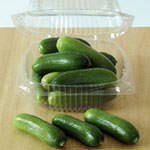
A little garden can go a long way, especially when it comes to growing delicious, nutritious vegetables.
Small spaces are the driving principle behind a new, chic way to garden. Micro-gardening means just what you think: growing small plants in small spaces. Raised beds, containers or even just a sunny corner of the backyard make perfect places to create your own industrious little Eden.
You can grow any type of vegetable in a micro-garden, but pocket-sized varieties allow for a broader selection and easier cultivation. Micro-greens like baby spinach, chard and lettuce are often micro-garden staples, so plan for these.
To step out of the box and grow a diverse and fruitful micro-garden of your own, start with these seven outstanding plants:
1. Extra Dwarf Bok Choy
The cutest little vegetable you’ll ever see, this bok choy is easy to grow, tasty and carefree. Crunchy miniature heads mature in as little as 30 days. With white petioles and dark-green leaves growing only 2 inches high, they are used whole in stir-fries and soups and raw in salads.
Start seeds directly in the garden in early- to mid-spring and again in late summer for fall harvests.
2. Round Romeo Baby Carrot
Looking much like orange ping pong balls, round Romeo baby carrots are just as tasty and nutritious as their full-sized brothers. These little, round carrots grow well in rocky and clay soils where straight carrots are prone to forking. Because they’re short and sweet, they don’t require any of the careful soil preparation that growing perfect, straight carrots requires.
Head out to the garden anytime between early-spring and late-summer and sow seeds 1/4 inch deep. If you continue to sow a handful of seeds every two weeks though the summer, you’ll be harvesting until frost and possibly beyond.

Courtesy JohnnySeeds.com
3. Fino Verde Basil
Italian basil at its finest—and tiniest—fino verde basil grows into a small, round bush and is covered with thumbnail-sized, sweet-and-spicy leaves. Start seeds indoors 4 to 6 weeks before the last expected frost, or sow seeds directly in the garden (or container) after the danger of frost has passed.
At maturity, this basil variety reaches a mere 18 inches in height and tends to flower several weeks later than other sweet basil varieties, making its delicious flavor last even longer. Use it in the kitchen as you would any full-sized basil variety. Fino verde basil just happens to put all its punch in a littler package.
4. Jingle Bells Pepper
A hybrid sweet pepper whose dapper little green fruits mature to a brilliant, glossy red, Jingle Bells peppers will soon have you picking a new micro-garden favorite. Its terrifically good production coupled with its superior taste make this diminutive pepper a top-notch choice for the micro-garden. (Plus there’s no need for staking!)
The peppers measure 1½ inches across, and the plant itself reaches only 18 to 24 inches high. Start seeds indoors under lights about 10 weeks before planting outside. Peppers are a warm-season crop, so hold off on moving the transplants outdoors until well after the danger of frost has passed.

Courtesy JohnnySeeds.com
5. Fairy Tale Eggplant
A simply gorgeous vegetable that tastes as good as it looks! The oblong fruit is a soft lavender color streaked with creamy white. Fairy tale eggplant has a miniature stature (it reaches only 18 inches in height) and the small fruits are a perfect single-serving size.
To grow these little beauties, start seeds indoors 8 to 10 weeks before your average last-frost date, then set them into the garden or in containers once the weather warms.
6. Red Robin Tomato
Red Robin matures at a mere 18 inches in height, so it’s downright perfect for your new micro-garden. As further proof that size doesn’t really matter, the Red Robin tomato’s 1-inch fruits are surprisingly productive, not to mention super sweet.
You can grow your micro-tomatoes in the ground, in containers or in hanging baskets. No staking or pruning is necessary. Start your own from seed under fluorescent lights indoors. Plant the seeds about 6 weeks before your average last-frost date, and they’ll be ready to transplant outdoors by mid- to late-spring.

Courtesy JohnnySeeds.com
Rocky Cucumber
This super-cute cuke is best harvested somewhere between the size of a cocktail weenie and a bun-sized hot dog. Rocky cucumbers don’t take up much space (the vines are not overly enthusiastic growers so no pruning is necessary), making this cucumber variety a great choice for in-ground micro-gardens or container culture.
Rocky cucumbers are easy to start from seed outdoors after the danger of frost has passed. Provide a climbing trellis to save even more garden real estate. Because the vines are resistant to powdery mildew, they’re a great choice for beginner gardeners, too.
About the Author: Jessica Walliser is the author of Good Bug Bad Bug: Who’s Who, What They Do and How to Manage Them Organically. Jessica lives and gardens with her husband and son, two dogs, six chickens, two fish, and millions of good bugs on 2 acres just outside the city.




